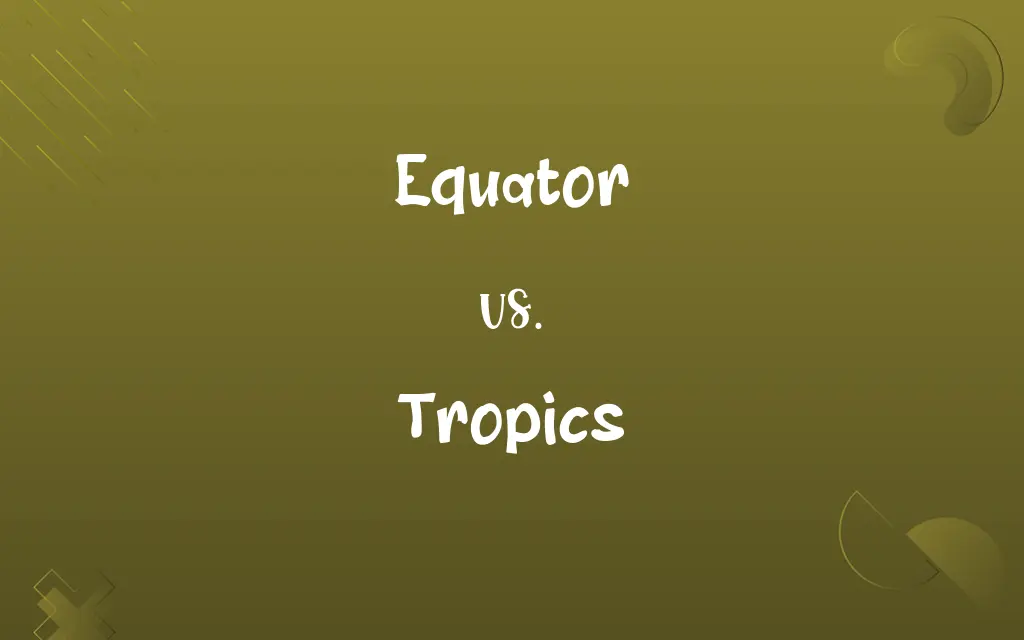Equator vs. Tropics: Know the Difference

By Shumaila Saeed || Updated on December 26, 2023
The Equator is an imaginary line around the earth's middle, dividing it into Northern and Southern Hemispheres. The Tropics are regions near the Equator, between the Tropic of Cancer and Tropic of Capricorn.

Key Differences
The Equator is an imaginary line encircling the Earth, equidistant from the North and South Poles, defining the boundary between the Northern and Southern Hemispheres. The Tropics refer to the regions of Earth near the Equator, specifically between the Tropic of Cancer in the north and the Tropic of Capricorn in the south.
Shumaila Saeed
Dec 26, 2023
The Equator represents the point of zero degrees latitude, serving as a reference for global navigation and climate patterns. In contrast, the Tropics are defined by latitudes 23.5 degrees north (Tropic of Cancer) and south (Tropic of Capricorn), encompassing a zone known for its warm climate.
Shumaila Saeed
Dec 26, 2023
The Equator experiences relatively consistent weather, with equal day and night lengths throughout the year. Meanwhile, the Tropics are characterized by distinct wet and dry seasons, and the sun can be directly overhead at least once a year.
Shumaila Saeed
Dec 26, 2023
The Equator is significant in geographical terms, influencing global wind patterns and ocean currents. On the other hand, the Tropics host diverse ecosystems, such as rainforests and savannas, that thrive in warm, humid conditions.
Shumaila Saeed
Dec 26, 2023
The Equator is a purely geographical concept, without any direct climatic implication. However, the Tropics are defined both geographically and climatically, as they denote the area of Earth experiencing the most direct sunlight.
Shumaila Saeed
Dec 26, 2023
ADVERTISEMENT
Comparison Chart
Definition
Imaginary line at 0° latitude
Regions between Tropic of Cancer and Capricorn
Shumaila Saeed
Dec 26, 2023
Sun Position
Sun directly overhead at equinoxes
Sun directly overhead at solstices
Shumaila Saeed
Dec 26, 2023
ADVERTISEMENT
Equator and Tropics Definitions
Equator
The zero latitude line from which all other latitudes are measured.
Countries located on the Equator experience little seasonal variation in daylight.
Shumaila Saeed
Dec 26, 2023
Tropics
Regions between the Tropic of Cancer and Tropic of Capricorn.
Many tropical countries have rich cultural traditions influenced by their climate.
Shumaila Saeed
Dec 26, 2023
Equator
A reference line for Earth's climate and time zones.
Time zones are often measured in relation to their distance from the Equator.
Shumaila Saeed
Dec 26, 2023
Tropics
The area of Earth surrounding the Equator, known for its warm climate.
The Tropics are home to diverse wildlife and lush vegetation.
Shumaila Saeed
Dec 26, 2023
Equator
An imaginary line that circles the globe at equal distance from both poles.
The equatorial region is known for its dense rainforests.
Shumaila Saeed
Dec 26, 2023
ADVERTISEMENT
Tropics
Regions globally recognized for their distinct environmental and climatic features.
Tropical islands are popular tourist destinations due to their beautiful beaches.
Shumaila Saeed
Dec 26, 2023
Equator
A conceptual line important for navigation and geography.
Navigators use the Equator as a baseline for plotting courses.
Shumaila Saeed
Dec 26, 2023
Tropics
A zone where the sun can be directly overhead at certain times of the year.
In the Tropics, the sun's intensity can lead to a hotter climate.
Shumaila Saeed
Dec 26, 2023
Equator
A global dividing line between the Northern and Southern Hemispheres.
Ecuador is named for its location along the Equator.
Shumaila Saeed
Dec 26, 2023
Tropics
Areas characterized by a warm, humid climate year-round.
The Tropics often experience heavy rainfall and have diverse ecosystems.
Shumaila Saeed
Dec 26, 2023
Equator
The imaginary great circle around the earth's surface, equidistant from the poles and perpendicular to the earth's axis of rotation. It divides the earth into the Northern Hemisphere and the Southern Hemisphere.
Shumaila Saeed
Oct 19, 2023
Equator
A similar great circle drawn on the surface of a celestial body at right angles to the axis of rotation.
Shumaila Saeed
Oct 19, 2023
Tropics
(geography) The region of the Earth centred on the equator and lying between the Tropic of Cancer and the Tropic of Capricorn and characterized by a hot climate.
Shumaila Saeed
Oct 19, 2023
Tropics
The part of the Earth's surface between the Tropic of Cancer and the Tropic of Capricorn; characterized by a hot climate
Shumaila Saeed
Oct 19, 2023
Equator
A circle that divides a sphere or other surface into congruent parts.
Shumaila Saeed
Oct 19, 2023
Equator
An imaginary great circle around Earth, equidistant from the two poles, and dividing earth's surface into the northern and southern hemisphere.
Shumaila Saeed
Oct 19, 2023
Equator
(astronomy) A similar great circle on any sphere, especially on a celestial body, or on other reasonably symmetrical three-dimensional body.
Shumaila Saeed
Oct 19, 2023
Equator
The midline of any generally spherical object, such as a fruit or vegetable, that has identifiable poles.
Slice the onion through the equator.
Shumaila Saeed
Oct 19, 2023
Equator
The imaginary great circle on the earth's surface, everywhere equally distant from the two poles, and dividing the earth's surface into two hemispheres.
Shumaila Saeed
Oct 19, 2023
Equator
The great circle of the celestial sphere, coincident with the plane of the earth's equator; - so called because when the sun is in it, the days and nights are of equal length; hence called also the equinoctial, and on maps, globes, etc., the equinoctial line.
Shumaila Saeed
Oct 19, 2023
Equator
An imaginary line around the Earth forming the great circle that is equidistant from the north and south poles;
The equator is the boundary between the northern and southern hemispheres
Shumaila Saeed
Oct 19, 2023
Equator
A circle dividing a sphere or other surface into two usually equal and symmetrical parts
Shumaila Saeed
Oct 19, 2023
Repeatedly Asked Queries
How is the Equator significant for climate?
It's a region with consistent weather and equal day/night lengths.
Shumaila Saeed
Dec 26, 2023
What is the Equator?
An imaginary line around Earth's middle, dividing it into two hemispheres.
Shumaila Saeed
Dec 26, 2023
Are the Tropics always hot?
Generally yes, due to their proximity to the Equator and direct sunlight.
Shumaila Saeed
Dec 26, 2023
Is the Equator the hottest part of Earth?
Not necessarily, as altitude and other factors influence temperature.
Shumaila Saeed
Dec 26, 2023
Can the sun be directly overhead at the Equator?
Yes, especially during equinoxes.
Shumaila Saeed
Dec 26, 2023
What wildlife is found in the Tropics?
Diverse species, including many unique to tropical climates.
Shumaila Saeed
Dec 26, 2023
What are the Tropic of Cancer and Capricorn?
Lines marking the northern and southern boundaries of the Tropics.
Shumaila Saeed
Dec 26, 2023
What defines the Tropics?
Regions between the Tropic of Cancer and Capricorn, known for warm climates.
Shumaila Saeed
Dec 26, 2023
What is the temperature range at the Equator?
Generally warm, but can vary with altitude and geography.
Shumaila Saeed
Dec 26, 2023
How do the Tropics impact global weather?
They influence weather patterns, including monsoons and trade winds.
Shumaila Saeed
Dec 26, 2023
How does the Equator affect global navigation?
It serves as a fundamental reference point for latitude.
Shumaila Saeed
Dec 26, 2023
What is the length of day at the Equator?
Roughly equal throughout the year.
Shumaila Saeed
Dec 26, 2023
How does the Equator affect time zones?
Time zones are often measured east or west from the prime meridian, not directly related to the Equator.
Shumaila Saeed
Dec 26, 2023
Do the Tropics have seasons?
Yes, typically wet and dry seasons, rather than temperate seasonal changes.
Shumaila Saeed
Dec 26, 2023
Are there deserts in the Tropics?
Yes, some desert regions exist within tropical latitudes.
Shumaila Saeed
Dec 26, 2023
What cultures are found along the Equator?
Diverse cultures, often influenced by the equatorial environment.
Shumaila Saeed
Dec 26, 2023
What makes the Tropics unique for biodiversity?
Warm temperatures and ample rainfall support diverse ecosystems.
Shumaila Saeed
Dec 26, 2023
Can you see the Northern Lights from the Equator?
Typically no, as they occur closer to the poles.
Shumaila Saeed
Dec 26, 2023
Are hurricanes common in the Tropics?
Yes, especially in areas with warm ocean waters.
Shumaila Saeed
Dec 26, 2023
Share this page
Link for your blog / website
HTML
Link to share via messenger
About Author
Written by
Shumaila SaeedShumaila Saeed, an expert content creator with 6 years of experience, specializes in distilling complex topics into easily digestible comparisons, shining a light on the nuances that both inform and educate readers with clarity and accuracy.









































































